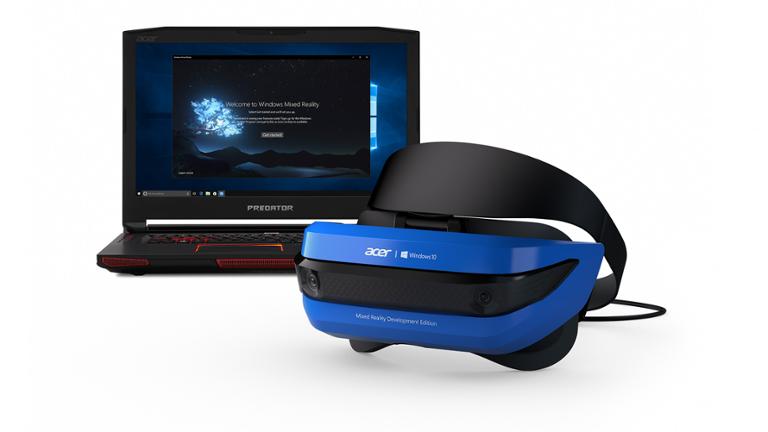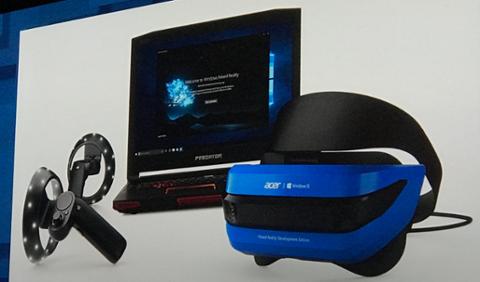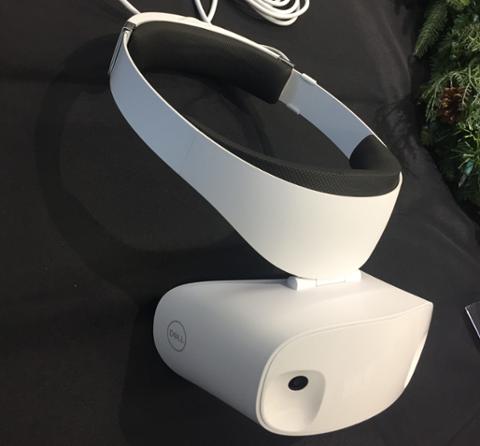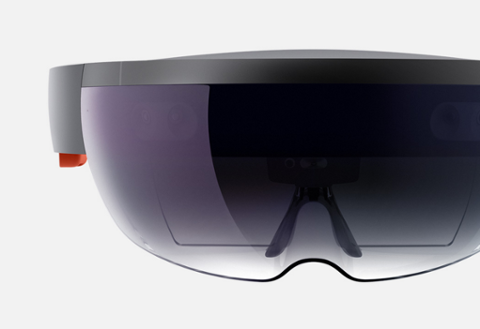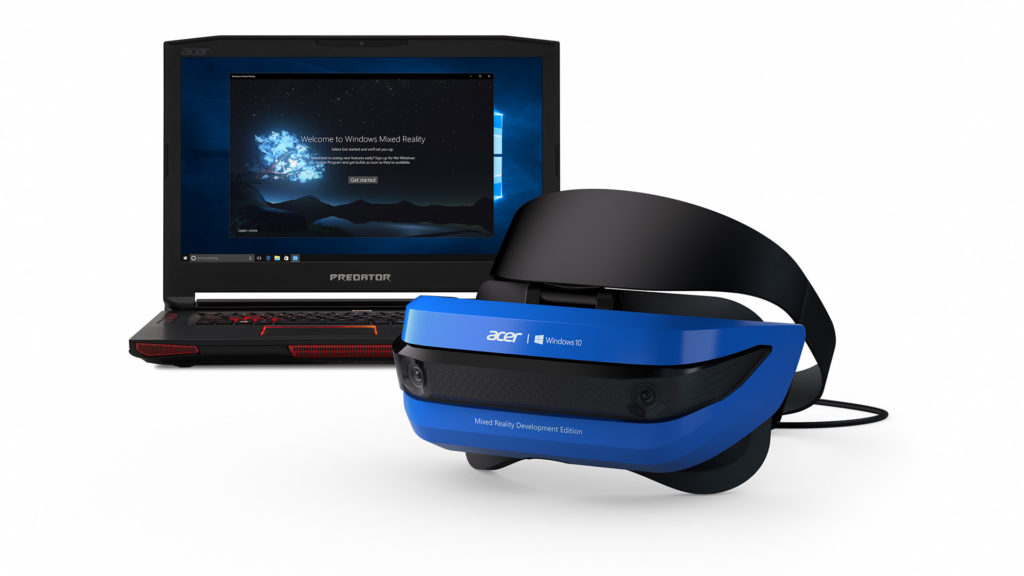 Microsoft has released two “mixed reality” headsets. Although described on the Microsoft Store’s Website as “Developer Editions,” the hardware is technically available to anyone with a credit card. Haven’t heard of “mixed reality”? It’s a term that’s existed for years, and meant to encompass both augmented reality (AR) and virtual reality (VR). As Alex Kipman, inventor of Microsoft’s HoloLens headset, told an audience at the company’s Build conference in May, AR and VR are just different points on a “mixed reality continuum.” So in theory, these two headsets—a $299 edition from Acer and a $329 one from Hewlett-Packard—will provide an AR and VR experience in one handy package, although the respective designs suggest that VR will end up a bigger focus: Unlike the HoloLens, which looks like a pair of sunglasses crossbred with a laptop, these headsets feature opaque fronts that flip up on a hinge. Specifications for both devices include two high-resolution LCD displays (1440 x 1440) with 95 degrees’ horizontal field of view, a display refresh rate of up to 90 Hz (native), built in audio out and microphone support, and a four-meter cable. Microsoft’s system recommendations for app developers include Windows 10 – Creators Update (with Developer Mode enabled), a desktop with an Intel i7 (6+ core) or AMD Ryzen 7 (8-core, 16 threads) processor and a powerful graphics GPU, and a Windows Display Driver Model (WDDM) 2.2 graphics driver. These “mixed reality” headsets will compete against not only high-end VR devices such as the Oculus Rift and the HTC Vive, but also middle-tier options such as Google’s Daydream VR. Apple is likewise working hard on AR, as evidenced by the unveiling of the ARKit for developers at this year’s WWDC conference. This is still a new field for companies and developers alike. For those developers interested in what Microsoft’s take on “mixed reality” can do, in terms of creating apps and games, check out the company’s Dev Center page, which offers everything from design guides and code samples to forums. There’s also a set of open-source projects to explore, although the actual offerings are minimal at the moment.
Microsoft has released two “mixed reality” headsets. Although described on the Microsoft Store’s Website as “Developer Editions,” the hardware is technically available to anyone with a credit card. Haven’t heard of “mixed reality”? It’s a term that’s existed for years, and meant to encompass both augmented reality (AR) and virtual reality (VR). As Alex Kipman, inventor of Microsoft’s HoloLens headset, told an audience at the company’s Build conference in May, AR and VR are just different points on a “mixed reality continuum.” So in theory, these two headsets—a $299 edition from Acer and a $329 one from Hewlett-Packard—will provide an AR and VR experience in one handy package, although the respective designs suggest that VR will end up a bigger focus: Unlike the HoloLens, which looks like a pair of sunglasses crossbred with a laptop, these headsets feature opaque fronts that flip up on a hinge. Specifications for both devices include two high-resolution LCD displays (1440 x 1440) with 95 degrees’ horizontal field of view, a display refresh rate of up to 90 Hz (native), built in audio out and microphone support, and a four-meter cable. Microsoft’s system recommendations for app developers include Windows 10 – Creators Update (with Developer Mode enabled), a desktop with an Intel i7 (6+ core) or AMD Ryzen 7 (8-core, 16 threads) processor and a powerful graphics GPU, and a Windows Display Driver Model (WDDM) 2.2 graphics driver. These “mixed reality” headsets will compete against not only high-end VR devices such as the Oculus Rift and the HTC Vive, but also middle-tier options such as Google’s Daydream VR. Apple is likewise working hard on AR, as evidenced by the unveiling of the ARKit for developers at this year’s WWDC conference. This is still a new field for companies and developers alike. For those developers interested in what Microsoft’s take on “mixed reality” can do, in terms of creating apps and games, check out the company’s Dev Center page, which offers everything from design guides and code samples to forums. There’s also a set of open-source projects to explore, although the actual offerings are minimal at the moment. Microsoft Headsets Give Devs a Shot at 'Mixed Reality'
 Microsoft has released two “mixed reality” headsets. Although described on the Microsoft Store’s Website as “Developer Editions,” the hardware is technically available to anyone with a credit card. Haven’t heard of “mixed reality”? It’s a term that’s existed for years, and meant to encompass both augmented reality (AR) and virtual reality (VR). As Alex Kipman, inventor of Microsoft’s HoloLens headset, told an audience at the company’s Build conference in May, AR and VR are just different points on a “mixed reality continuum.” So in theory, these two headsets—a $299 edition from Acer and a $329 one from Hewlett-Packard—will provide an AR and VR experience in one handy package, although the respective designs suggest that VR will end up a bigger focus: Unlike the HoloLens, which looks like a pair of sunglasses crossbred with a laptop, these headsets feature opaque fronts that flip up on a hinge. Specifications for both devices include two high-resolution LCD displays (1440 x 1440) with 95 degrees’ horizontal field of view, a display refresh rate of up to 90 Hz (native), built in audio out and microphone support, and a four-meter cable. Microsoft’s system recommendations for app developers include Windows 10 – Creators Update (with Developer Mode enabled), a desktop with an Intel i7 (6+ core) or AMD Ryzen 7 (8-core, 16 threads) processor and a powerful graphics GPU, and a Windows Display Driver Model (WDDM) 2.2 graphics driver. These “mixed reality” headsets will compete against not only high-end VR devices such as the Oculus Rift and the HTC Vive, but also middle-tier options such as Google’s Daydream VR. Apple is likewise working hard on AR, as evidenced by the unveiling of the ARKit for developers at this year’s WWDC conference. This is still a new field for companies and developers alike. For those developers interested in what Microsoft’s take on “mixed reality” can do, in terms of creating apps and games, check out the company’s Dev Center page, which offers everything from design guides and code samples to forums. There’s also a set of open-source projects to explore, although the actual offerings are minimal at the moment.
Microsoft has released two “mixed reality” headsets. Although described on the Microsoft Store’s Website as “Developer Editions,” the hardware is technically available to anyone with a credit card. Haven’t heard of “mixed reality”? It’s a term that’s existed for years, and meant to encompass both augmented reality (AR) and virtual reality (VR). As Alex Kipman, inventor of Microsoft’s HoloLens headset, told an audience at the company’s Build conference in May, AR and VR are just different points on a “mixed reality continuum.” So in theory, these two headsets—a $299 edition from Acer and a $329 one from Hewlett-Packard—will provide an AR and VR experience in one handy package, although the respective designs suggest that VR will end up a bigger focus: Unlike the HoloLens, which looks like a pair of sunglasses crossbred with a laptop, these headsets feature opaque fronts that flip up on a hinge. Specifications for both devices include two high-resolution LCD displays (1440 x 1440) with 95 degrees’ horizontal field of view, a display refresh rate of up to 90 Hz (native), built in audio out and microphone support, and a four-meter cable. Microsoft’s system recommendations for app developers include Windows 10 – Creators Update (with Developer Mode enabled), a desktop with an Intel i7 (6+ core) or AMD Ryzen 7 (8-core, 16 threads) processor and a powerful graphics GPU, and a Windows Display Driver Model (WDDM) 2.2 graphics driver. These “mixed reality” headsets will compete against not only high-end VR devices such as the Oculus Rift and the HTC Vive, but also middle-tier options such as Google’s Daydream VR. Apple is likewise working hard on AR, as evidenced by the unveiling of the ARKit for developers at this year’s WWDC conference. This is still a new field for companies and developers alike. For those developers interested in what Microsoft’s take on “mixed reality” can do, in terms of creating apps and games, check out the company’s Dev Center page, which offers everything from design guides and code samples to forums. There’s also a set of open-source projects to explore, although the actual offerings are minimal at the moment. 